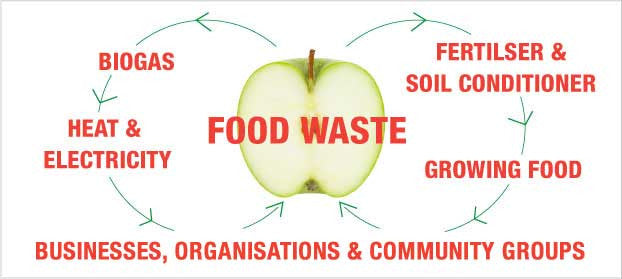
Anaerobic Digestion – How Does It Work Chemically?
Share
Feb 24, 2010 • By Harvest Power •
Turning waste materials into energy is a fantastic way to produce renewable power – but how does it really work?
The good news is that the process has been in operation for tens of millions of years – naturally – a variety of bacteria take long-chain hydrocarbons, like sugars, fatty acids and amino acids and break them down eventually producing “biogas,” an energy-rich gas that can be used as natural gas, or burned for electricity.
Multiple types of bacteria are involved in this process, and indeed the process takes different pathways if there is oxygen present or not. “Anaerobic” digestion describes this process without oxygen present, a critical factor in producing methane (CH4). In fact, some believe all of the natural gas present underground was formed through this anaerobic digestion process.
It is important to note that anaerobic digestion does not typically break down certain “tougher” molecules such as cellulose or hemicellulose, key molecules in wood and woody products. The process is most effective on simple sugars, fats and proteins that are found in food, foodwaste and manure. However, these anaerobic bacteria can break down cellulose and hemicelluloses over very long periods of time.
To put it all in simple chemical terms, here is a typical chemical pathway that takes place through anaerobic digestion: Glucose (C6H12O6) (this means a chemical bond with 6 carbon atoms, 12 hydrogen atoms and 6 Oxygen atoms) is eventually turned into 3 molecules of carbon dioxide (CO2) and 3 molecules of methane (CH4). This process can happen relatively quickly – in as little as two weeks, depending on the conditions of Ph, oxygen levels and temperature.
There are four chemical and biological stages in anaerobic digestion:
Hydrolysis – the first step in which longer chain carbohydrates, fats and proteins are broken into shorter chain molecules in solution. Some of these shorter chain molecules can be directly used in step 3 and 4 below.
Acidogenesis – this second step is a biological process, similar to what happens with milk souring, in which these shorter chain molecules produce carbon dioxide, hydrogen sulfide and even more volatile fatty acids.
Acetogenesis – in the third step, simple molecules created through the first two steps are digested by specific bacteria to produce largely acetic acid (CH3COOH), as well as carbon dioxide and hydrogen.
Methanogenesis – the last stage is a biological process in which a certain class of bacteria, known as methanogens utilize the products developed in stages one to three above and convert them into methane (natural gas), carbon dioxide and water. This stage is sensitive to pH, and is most prevalent at pH levels between 6.5 and 8.
One of the most fascinating aspects of this process is that it occurs every day inside a cow's stomach – they have these very same bacteria who do the work of producing energy for the cow, as well as the by-products of methane and carbon dioxide.
Is anaerobic digestion an effective way to extract methane from these foodwaste products?
This same chemical and biological pathway is in use around the world – most notably at waste water treatment plants – as well as over one thousand manure digesters in use at dairy farms. This process also occurs at landfills (from the waste buried within it). The process can move faster at higher temperatures (thermophilic, around 55-70 degress Celsius, or at mesophilic temperatures of 35-40 degrees Celsius).
Key ingredients for faster anaerobic digestion:
Water – the molecules must be effectively in solution to be digested
Temperature – the process can occur at lower temperatures, but temperatures of 35 to 70 degress Celsius allow it to move much more quickly
pH – the initial steps in the process produce significant volumes of acid (namely acetic acid), however the bacteria are most effective closer to a neutral pH of 6 to 8.
It is indeed fascinating that we can use trillions of naturally-occurring bacteria to do the “heavy lifting” of producing renewable energy from waste materials. Instead of all of the manufacturing and distribution required for oil, coal, or even solar panels, wind turbines or nuclear power plants, we can use these microscopic bacteria, found on every inch of the globe, to produce renewable energy in an effective and low-cost manner.

